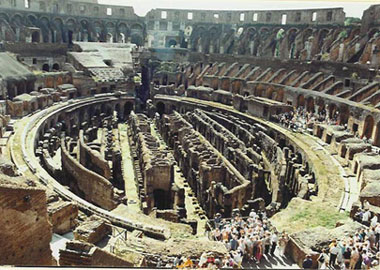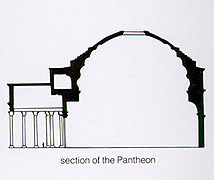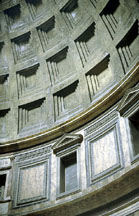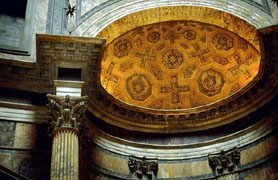.
The
Roman Empire

Reconstruction Model of Ancient Rome
|
Rome is located
on the Western shore of Italy (a peninsula which is shaped like a
lady's spike-heeled boot), dividing the Adriatic Sea to the east and
the Mediterranean to the southwest. Located on the banks of the Tiber
River, the city had excellent access to the sea and trade routes.
The Mediterranean waters also were effective in holding the sun's
rays during all seasons of the year, and releasing its warmth to the
surrounding lands each winter. The location had great potential for
the city destined to become the seat of the world empire.
The ocean provided
easy access to surrounding lands, which would become Rome's colonies.
Roman armies conquered ancient Greece, then travelled to the far reaches
of Europe, North Africa, and the Asia Minor, leaving Roman colonies
in its wake. At the height of the Roman Empire, "all roads lead
to Rome" was a true statement, because they built the roads.
One can still find evidence of Roman architecture and engineering
from England to Egypt.
|
|
Roman
Achievements in Architecture, Engineering, and City Planning
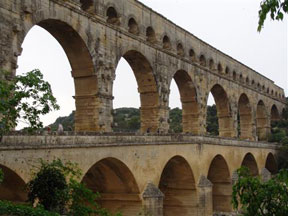
The Pont du Gard in Nimes, France
|
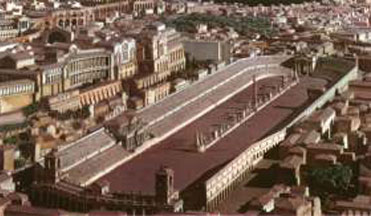
Circus Maximus, Reconstruction Model
|
| For Rome to
be successful in maintaining its huge empire, it had to construct roads
that stretched for hundreds of miles. Some of these had the double function
of serving as an aquaduct, carrying water from mountain springs to the
lower cities. The invention of the arch allowed them to span larger
areas with fewer beams. The arch was also more architecturally sound
than post and beam construction (the Pont du Gard, for example, has
stood for 2000 years). Indoor plumbing, public fountains and baths were
enjoyed by citizens. Streets were laid out according to a rational,
geometric pattern.
The Circus
Maximus was constructed for huge crowds to watch the Olympic games
and chariot races. Triumphal arches were erected to comemmorate victory
in battles, and were covered with elaborate stone carvings and statuary. |
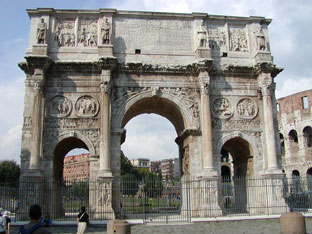
Triumphal Arch of Constantine, Rome
|
The Colosseum is perhaps the
most famous of Roman architectural ruins. Its immense size, covering six
acres and accommodating 50,000 spectators, is enough reason for its fame.
What it was used for is perhaps even more note-worthy, as we know that this
is where bloody fights between exotic animals and gladiators occured. A
complex system of pipes drained the blood-bathed stadium floor.. The picture
at right shows the underground tunnels beneath the floor of the stadium.
The wild animals were contained here until the big event. There were 80
doorways allowing the huge crowds quick entrance and exit from the stadium.
The columns which are spaced between each of the arches imitate progression
of Greek orders: the Doric columns are on the first floor, the Ionic on
the second, and the Corinthian on the third. The uppermost level of the
structure once held pillars which held a giant canopy to shield the spectators
from the sun. Lower class citizens sat close to the canopy, where it was
hottest. Some more facts about the Colosseum.
The Pantheon
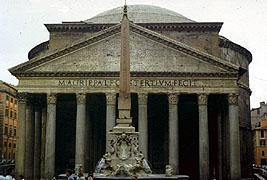
The Pantheon
was the first temple to combine concrete construction with the decorative
use of Greek classical orders. The building is an immense cylinder
topped with a dome. The structure is 142 feet high and 140 feet across,
making an almost hemispherical interior. There is a 29 foot wide oculus
(eye) at the top, allowing ventillation and light to enter. A dome
of this size would not have been possible without the Roman invention
of concrete.
|
|
The cross-section
shows how the walls of the dome became thinner as they reached the oculus,
preventing collapse from the weight. The invention of coffers (recessed
blocks) also achieved this aim. Seven niches surrounding the base of the dome
originally held statues of their gods. The Pantheon is now a Christian church
called Santa Maria della Rotonda. The pagan statues were removed and replaced
with Christian saints, and the half-dome above the altar is covered with Christian
crosses.
Roman Mosaics
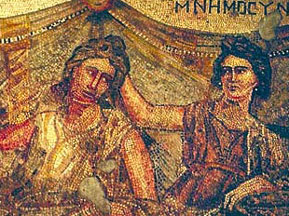
detail from a banquet |
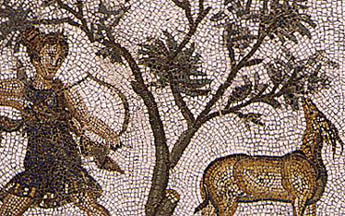
Diana, the huntress-goddess |
A mosaic is created by assembling small pieces
of tile, glass, or stone into a mortar background, forming a pattern
or picture. The Romans followed the Greek tradition in creating this
form of art, probably beginning in the 3rd or 4th century. Theirs consisted
of cut stones, and were usually used for floors. Subjects included depictions
of their gods, legendary heroes of Greek and Roman literature, depictions
of daily life, and images of nature. |
More Ancient Mosaics
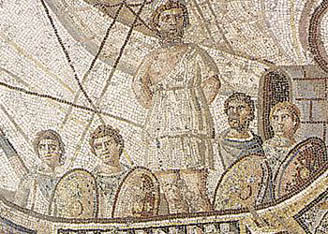
Ullyses, listening to the sirens |
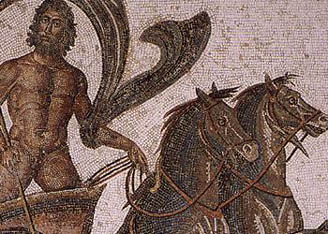
The Victory of Neptune |
The Recovery
of an Ancient City: Pompeii
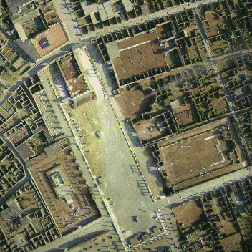
Aerial of Pompeii's Forum
|
Pompeii became
a Roman city in 80 B.C.E. It was buried under volcanic ashes in 79 C.E.,
and lay undisturbed until 1748, when it was discovered by accident.
Some of the most important archeological discoveries are the many painted
frescos which were in the residences of some of the wealthier homes.
They give us a clue to the quality of painting that may have once existed
throughout the Roman Empire.
Below is one
section of 4 wall-friezes that surrounded a living-room in Pompeii.
They are believed to depict the ceremonies of the Dionysiac Mystery
cults (Dionyses was the Greek god of Wine and Ecstacy, which continued
to be worshipped by some Romans, who renamed the god Bachus). The largest
painting to survive from antiquity, it was preserved by the volcanic
ashes that filled the room - preventing weather from eroding its brilliant
colors. (The bright red background, so
often used in their murals, is known by many artists and designers as
"Pompeian Red")
|
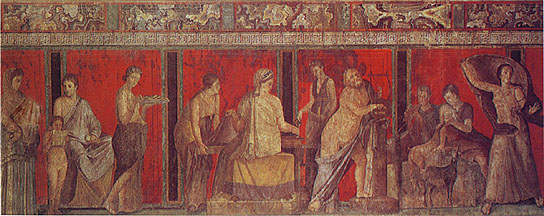
Villa of the Mysteries, Pompeii c. 50 B.C.E.
Roman
Sculpture
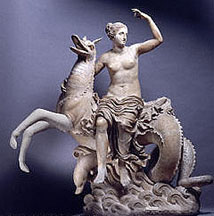
Nereid Riding a Sea Serpent
|

Neptune, God of the Seas
|
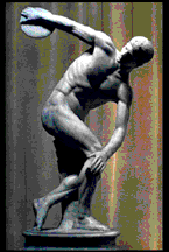
Discus Thrower
|
Though most Roman
sculptures strove for complete realism, images of gods and goddesses were
often idealized. Also, they made great efforts to preserve the legacy of the
Ancient Greeks by creating perfect copies of many of their broken sculptures. The Discus Thrower is an
example of Greek Classical idealism, which they preserved. For the most part,
however, you can trust Roman sculpture to be a faithful likeness of the person
portrayed. This is especially true of bust-portraits of Rome's prominent citizens
and politicians (many of whom were not at all handsome). Any Roman citizen
who could afford it might have their likeness carved in marble, and multiple
carvings were created of all of the Emperors.

Flavian Woman
1st century C.E.
|
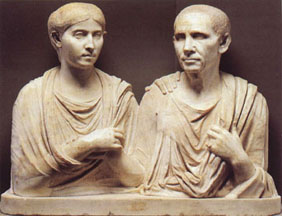
Roman Couple
|

Emperor Hadrian
|

Emperor Constantine, 315 C.E. |
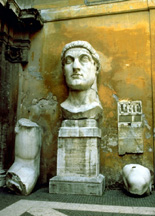
Constantine Fragments
|
The colossal portrait of Constantine
shows the emperor's commanding presence. The head alone is 8 feet tall,
and only fragments of other portions of his body remain (the whole body,
seated on a throne, was once over 30 feet tall, partly constructed of brick
and wood). His reign was towards the end of the Empire, as Rome was decreasing
its hold on its colonies and was subject to continual invasions. He was
the first Roman Emperor to accept Christianity, even establishing Christian
churches outside of the capital of Rome. When he moved the capital to Byzantium,
he called the new city "Constantinople". This split the power
of the empire in two, hastening the end of the empire.
The western portion (Rome and
its surroundings) was repeatedly sacked by Germanic tribes (the Visigoths
in 376, the Vandals in 408, the Goths in 410, and Attila the Great led the
Huns in its final defeat in 450). The eastern portion of Constantinople
maintained its power, and began the new age of Christianity, beginning with
a period known as "Byzantine".
Next: Medieval Art
|







